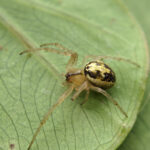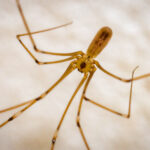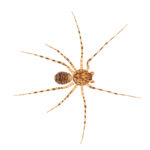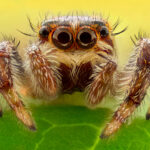What Are The Common Spiders In The UK?
- What Are The Common Spiders In The UK?
- Common false widow spider (Steatoda bipunctata)
- Giant House Spider (Eratigena atrica)
- Sector Spider (Zygiella)
- Daddy long-legs spider (Pholcidae)
- Cupboard spider (Steatoda grossa)
- Spitting spider (Scytodidae)
- Jumping spiders (Salticidae)
- The mouse spider (Scotophaeus Blackwalli)
- Noble False Widow Spider (Steatoda nobilis}
- Pest Control For Spiders
- Frequently Asked Questions
What Are The Common Spiders In The UK?
As a team of UK-based Pest controllers, we know that spiders are a common sight in many households nationwide. Some people may find these eight-legged creatures fascinating, while others might feel scared or anxious at their presence. Knowing which types of spiders are most likely to appear in your home or garden is useful regardless of where you stand on the spider spectrum.
In this post, we’ll explore some of the most common spiders in the UK. From false widows to giant house spiders, we’ll give you an overview of each species and their appearance. We’ll also provide some tips on identifying and dealing with spider infestations and debunking common myths about these arachnids. So whether you’re a spider enthusiast or simply looking for ways to keep your home spider-free, read on for our guide to the common spiders in the UK.
Common false widow spider (Steatoda bipunctata)
Watch out for the false widow spider – a potential danger lurking in your home. This scary spider is one of the most common in the UK, and while it’s not as dangerous as its close relative, the black
If you spot a false widow spider in your home, don’t panic. Instead, it’s important to call pest control experts like Youngs Pest Control to remove them safely and effectively. Trying to remove or control them yourself can lead to bites which require medical attention. Pest control professionals will also be able to advise on treatment for infestations.
False widows are notorious for causing panic among homeowners due to their appearance, but you can keep them under control with proper pest control measures. Remember that spotting one doesn’t necessarily mean there’s an infestation present – they may have wandered inside looking for food or shelter.
Giant House Spider (Eratigena atrica)
Seeing a Giant House Spider scurrying across your living room floor is enough to make anyone’s skin crawl. These spiders are one of the largest species in the UK, with leg spans reaching up to 
Despite their size, Giant House Spiders are not venomous and pose no threat to humans. However, this doesn’t stop them from being a common source of fear for many people. Studies have shown that arachnophobia is one of the most common phobias in the world.
If you find yourself face-to-face with one of these eight-legged creatures, it’s important to remember that they are just trying to go about their business like any other animal. So instead of squashing or killing them, try gently capturing and releasing them outside to continue their natural role as pest controllers in our ecosystem. After all, spiders play an important role in keeping our homes free from unwanted insects like flies and mosquitoes.
Sector Spider (Zygiella)
The Sector Spider (Zygiella) is a fascinating arachnid across Europe with its distinctive zigzag web pattern. Known for its small size and brownish-yellow colour, this spider is commonly found in
One interesting feature of the Sector Spider is its ability to adjust the spacing between each section of its web. This allows it to catch prey of various sizes, from tiny flies to larger insects like moths and beetles. The spider can also remove and rebuild sections of its web as needed, making it a highly adaptable predator.
Despite their common presence in homes and gardens, Sector Spiders are not considered harmful to humans. They rarely bite unless provoked, and their venom is not dangerous. So if you find one in your living space, there’s no need to panic – admire this fascinating creature from a safe distance!
Daddy long-legs spider (Pholcidae)

Daddy long-leg spiders are known for their delicate appearance, but don’t be fooled by their fragility – they’re quite resilient. These spiders have adapted well to living indoors and can thrive in areas where other insects may struggle. In addition, they build messy webs that serve as traps for other bugs, making them an important natural pest control agent.
While some people may find Daddy long-legs spiders creepy or unsettling, they play an important role in our ecosystem. As predators of pests such as mosquitoes and flies, they help keep our homes free from unwanted insects. So just remember, next time you come across one of these spiders in your home or garden, remember how beneficial they can be!
Cupboard spider (Steatoda grossa)
Double-check your cupboards after reading about the creepy Cupboard spider (Steatoda grossa)! This species is commonly found in homes across the UK, often lurking in dark corners or behind
Despite its ominous name and appearance, the Cupboard spider is not dangerous to humans. However, it can give you a painful bite if provoked or threatened. Symptoms of a bite may include swelling, redness, and localized pain lasting several hours. If you have you have been bitten by this spider or any other venomous creature, seek medical attention immediately.
Spitting spider (Scytodidae)

The spitting spider’s unique hunting technique sets it apart from other spider species. It doesn’t rely on webs or pouncing on its prey. Instead, it shoots out silk strands coated with venom at its target from up to six centimetres! This immobilizes the prey by glueing its limbs together before the spider moves in for the kill.
Here are some interesting facts about this unusual arachnid:
1. Despite their ability to spit venom, spitting spiders aren’t considered dangerous to humans.
2. Like most spiders, They have six eyes arranged in three pairs instead of eight.
3. Spitting spiders are quite fast and agile despite their small size.
4. The silk strands these spiders shoot can travel faster than 100 meters per second!
In conclusion, even though the spitting spider isn’t commonly found in the UK, it’s still worth knowing about this fascinating creature with its unique hunting skills and unusual features, such as six eyes instead of eight! So next time you come across an unfamiliar-looking spider, look closer – you might just discover something new and exciting!
Jumping spiders (Salticidae)
Jumping spiders (Salticidae) are a fascinating species you should know. These small, brightly coloured spiders have excellent vision and are known for their impressive jumping abilities. They use
One of the most interesting aspects of jumping spiders is their courtship rituals. Male jumping spiders will perform intricate dances and displays to attract females, sometimes using vibrations or sounds to communicate. This behaviour is entertaining to watch and can provide insight into these amazing arachnids’ social behaviour.
Despite their impressive physical abilities and intriguing behaviours, jumping spiders are generally harmless to humans. Their venom is not considered dangerous, and they typically do not bite unless provoked or threatened. So next time you come across one of these little acrobats, take a moment to appreciate their unique characteristics and observe them in action!
The mouse spider (Scotophaeus Blackwalli)

As their name suggests, mouse spiders are often found in environments where mice live, such as fields, meadows, and forests. They tend to be active during the night when they hunt for insects like moths and flies. Despite being venomous, their bites are not considered dangerous to humans as they are not aggressive unless provoked.
Mouse spiders can be found throughout the UK but are more commonly seen in southern regions. Their nocturnal tendencies make them difficult to spot during the day unless you know where to look. If you come across one of these fascinating creatures on your outdoor adventures, take a moment to appreciate their unique features and observe their hunting habits from a distance.
Noble False Widow Spider (Steatoda nobilis}
You may be surprised to learn that the Noble False Widow Spider has made its way into your garden shed or garage with its distinctive cream-coloured markings and shiny black body. Originally
Due to their similar appearance, the Noble False Widow Spider is often mistaken for other species, such as the Common House Spider or even a Black Widow Spider. However, some distinguishing features, such as the cream-coloured marking on its abdomen, resemble a skull shape. It prefers warm and dry environments such as sheds, garages, and lofts.
Despite their intimidating appearance, these spiders are unlikely to cause harm unless provoked or threatened. You may see one in your home or garden shed; it’s best to leave them alone and call us at Youngs Pest Control expert if you feel uncomfortable dealing with them. It’s important to remember that spiders play an important role in our ecosystem by helping control insect populations, so they should be respected rather than feared.
Pest Control For Spiders
Don’t let those creepy crawlies take over your home – learn how to control and prevent spider infestations effectively! As a team of pest control experts, we have seen our fair share of spider problems. Luckily, several ways exist to keep these arachnids at bay without resorting to harmful chemicals or sprays. Here are three effective methods for controlling spiders in your home:
1. Keep your space clean: Spiders love cluttered areas where they can easily hide and build webs. Regularly cleaning and decluttering your home removes their hiding spots and make it harder for them to thrive.
2. Seal up cracks: Spiders can easily enter through small cracks or gaps in doors or windows. Make sure to seal up any openings with caulk or weather stripping to prevent them from getting inside.
3. Use natural deterrents: Natural remedies can repel spiders, including essential oils like peppermint and tea tree oil, vinegar solutions, and citrus peels. These options keep spiders away and leave your home smelling fresh.
By implementing these simple yet effective strategies, you can significantly reduce the number of spiders in your home without harming them or using toxic chemicals.
Remember that prevention is key in pest control – by taking proactive steps today, you can avoid future infestations and enjoy a spider-free living space!
Frequently Asked Questions
How many species of spiders are found in the UK?
As we explored the diverse wildlife of the United Kingdom, I was taken aback by the sheer number of spider species in this country. Did you know that there are over 670 different types of spiders found in the UK? From common house spiders to the more elusive wolf spiders and jumping spiders, these arachnids can lurk in gardens, forests, and even our homes. Despite their creepy reputation, many of these species play a crucial role in maintaining ecological balance and should be appreciated for their unique adaptations and behaviours.
What is the difference between a false widow spider and a noble false widow spider?
Let’s discuss the difference between a false widow spider and a noble false widow spider. These spiders are commonly found in the UK but have distinct characteristics that set them apart. The false widow spider, also known as Steatoda nobilis, has a bulbous abdomen with cream-coloured markings and can be mistaken for the venomous black widow spider. On the other hand, the noble false widow spider or Steatoda grossa has a rounder body with brownish-grey colouration and distinctive white markings on its back. While both spiders are not considered dangerous to humans unless provoked, it is essential to differentiate between these species for identification purposes.
Can spider bites be fatal in the UK?
As the saying goes, “It’s not the size of the spider that matters; it’s the venom it carries.” While many may believe that spider bites are harmless in the UK, there have been reported cases of fatalities resulting from spider bites. The most dangerous spiders in the UK are false widow spiders and noble false widow spiders. These venomous arachnids can cause various symptoms, including pain, swelling, and fever. While most people recover fully from their bites, those with compromised immune systems or allergies may be at greater risk for severe reactions. Therefore, it’s best to seek medical attention if a spider has bitten you and to take precautions to avoid encounters with these potentially deadly creatures.
How can I prevent spiders from entering my home?
We take a few simple steps to prevent spiders from entering our home. First, we keep the house clean and tidy – spiders are attracted to clutter and mess. We also seal up any cracks or gaps in doors and windows, as these can provide easy access points for spiders. Additionally, we use natural repellents like peppermint oil to deter spiders from entering our home. By taking these preventative measures, we’ve significantly reduced the number of spiders in our living space.
So, those are the common spiders you might encounter in the UK. Some may be harmless, while others can pose a threat to humans. But don’t let these eight-legged creatures scare you! With proper pest control measures, you can keep your home spider-free.
Prevention is better than cure. Regular cleaning and decluttering can help reduce spider habitats. Using essential oils like peppermint or eucalyptus also repels spiders. However, if the infestation persists, it’s best to seek professional help from pest control services. Remember that a spider-free home keeps you safe and promotes peace of mind and comfort for you and your family.
If you have other pest problems, we also cover:
